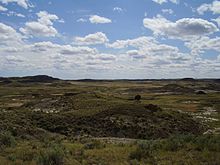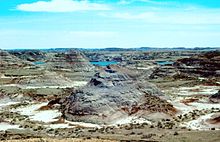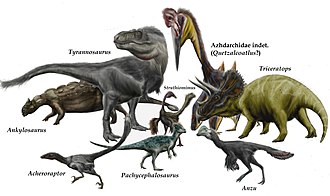Hell Creek Formation
The Hell Creek Formation is a sequence of Late Cretaceous and earliest Paleocene continental sedimentary rocks in the northwestern United States. It is named for the small stream Hell Creek near Jordan, Montana, and contains several important deposits of dinosaur fossils. The formation is exposed in the badlands of eastern Montana and parts of North Dakota, South Dakota, and Wyoming. The remains of popular dinosaur genera such as Tyrannosaurus, Triceratops, Ankylosaurus, and Edmontosaurus have been recovered from these outcrops. It also contains in its upper section the Iridium-enriched Cretaceous-Tertiary boundary layer, a thin layer also found elsewhere on Earth, whose upper interface separates the Mesozoic (Earth's Middle Ages) from the subsequent Cenozoic (Earth's Modern Era).
The Hell Creek Formation, which has been intensively studied geologically and paleontologically, consists of mudstones and sandstones formed from the deposits of rivers (fluvial) and lakes and ponds (lacustrine) between 67 and 65 million years ago, primarily during the Maastrichtian, the last stage of the Cretaceous. At the time of deposition, the rivers at the eastern edge of the formation's range emptied into the Western Interior Seaway, an epicontinental sea that extended across North America, from northern Canada to the Gulf of Mexico, during the Late Cretaceous (see also → Laramidia). Some of the easternmost deposits of the formation were therefore formed in coastal marshes. The presence of crocodilians suggests a subtropical climate without pronounced annual cold periods at the time of deposition.
Similar formations of the same age (lateral equivalents) to the Hell Creek Formation are the Lance Formation, which is more widespread to the south, and the Frenchman Formation and Scollard Formation in Canada. On the slope of the Hell Creek Formation follows the Paleocene Tullock Formation (or Tullock Subformation of the Fort Union Formation) and, in North and South Dakota, the Ludlow Formation (or Ludlow Subformation of the Fort Union Formation). The Hell Creek Formation is underlain by the Fox Hills Formation, which is still of oldest Maastrichtian age and is separated by a gap of about 2 million years.

Montana Badlands (Hell Creek Formation) .

The Hell Creek Formation, exposed at Ft. Peck Reservoir.
Fossils
An impressive amount of invertebrates, plants, mammals, fish, reptiles and amphibians have come from the Hell Creek Formation. In 2000, the most complete skeleton of a hadrosaurid dinosaur ever found was discovered. In addition to dinosaurs, the fossils of some birds and pterosaurs (flying dinosaurs) have also been found. Shark and ray teeth are also occasionally found in these river deposits, suggesting that some of these taxa were more tolerant of fresh water than they are today. Bony fishes include the sturgeon-like Paleopsephurus and Protoscaphirhynchus in the Hell Creek fauna.
The dinosaurs found include various theropods, such as the common genera Paronychodon and Ricardoestesia, the tyrannosaurs Tyrannosaurus rex and Nanotyrannus lancensis, the ornithomimosaur Ornithomimus sp., the caenagnathids Chirostenotes sp. and Elmisaurus elegans, and other maniraptors such as Troodon sp., cf. Dromaeosaurus, Avisaurus archibaldi, and the remains of velociraptorines.
The Ornithischia (avian pelvic dinosaurs) are represented by Ankylosaurus magniventris, Edmontonia sp., pachycephalosaurids like Dracorex hogwartsia, Pachycephalosaurus wyomingensis, Sphaerotholus bucholtzae and Stygimoloch spinifer, Ceratopsia like cf. Leptoceratops sp, Torosaurus latus, the very common Triceratops horridus and Triceratops prorsus, and finally ornithopods such as Bugenasaura infernalis, Thescelosaurus neglectus and the very common Edmontosaurus (Edmontosaurus annectens and Edmontosaurus sp.).
Some of the fossils from the Hell Creek Formation are commercially mined and marketed by companies. Usually these are bones, osteoderms, and teeth of dinosaurs, crocodiles, and fish. A representative collection of fossils from this formation is on display at the Museum of the Rockies in Bozeman, Montana.

Live reconstructions of various typical dinosaurs of the Hell Creek Formation. From back to front: Ankylosaurus, Tyrannosaurus, Quetzalcoatlus (a pterosaur), Triceratops, Struthiomimus, Pachycephalosaurus, Acheroraptor and Anzu.
Questions and Answers
Q: What is the Hell Creek Formation?
A: The Hell Creek Formation is a series of rocks where fossil dinosaurs are found. The strata are mostly Upper Cretaceous and some lower Paleocene rocks in North America.
Q: Where does the name come from?
A: The name comes from Hell Creek, near Jordan, Montana.
Q: What type of deposits make up the formation?
A: The formation includes fresh and brackish-water clays, mudstones, and sandstones deposited during the end of the Cretaceous period and the beginning of the Palaeogene. It was laid down in river channels and deltas, and occasional peaty swamp deposits.
Q: What type of climate existed at this time?
A: The climate was mild, and the presence of crocodilians suggests a sub-tropical climate with no prolonged annual cold.
Q: Where can you find fossils from this formation?
A:The world's largest collection of Hell Creek fossils is housed and exhibited at the Museum of the Rockies in Bozeman, Montana.
Q: Who is involved in collecting these fossils?
A:The specimens displayed are the result of a joint effort between the museum, Montana State University, University of California Berkeley, University of North Dakota, and University of North Carolina called "the Hell Creek Project". This project began in 1998.
Q: What types animals have been discovered within this formation?
A:Fossils discovered include all types late Cretceous dinosaurs, fish amphibia other reptiles such as turtles crocodylomorphs squamata (snakes & lizards) as well as multituberculates metatherians eutherians mammals
Search within the encyclopedia